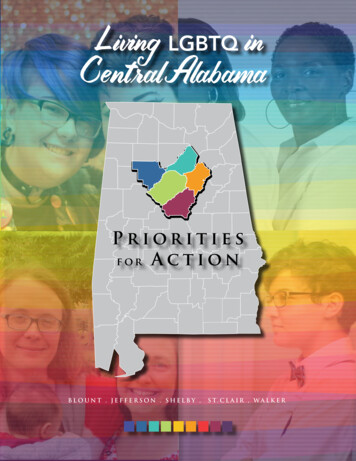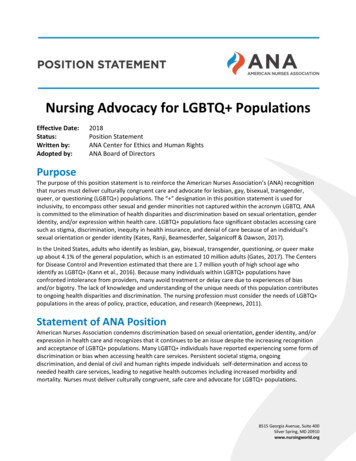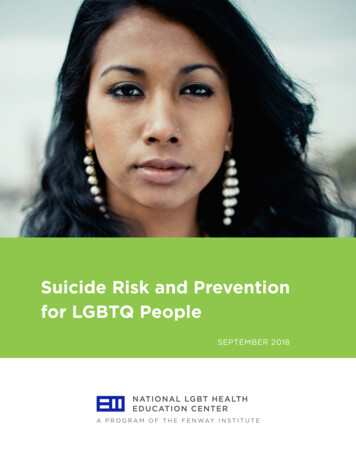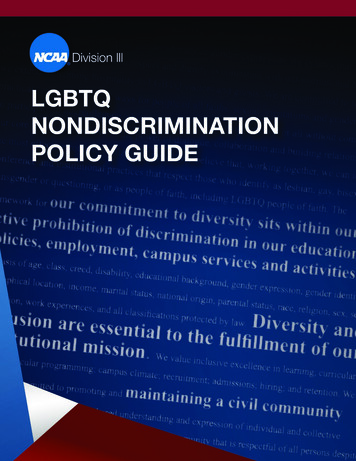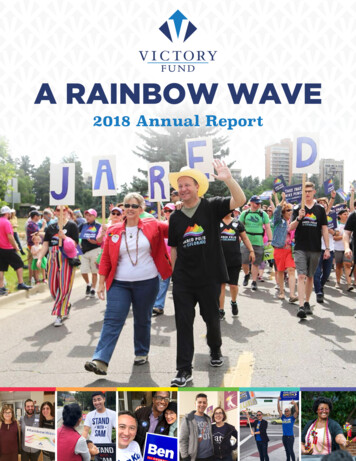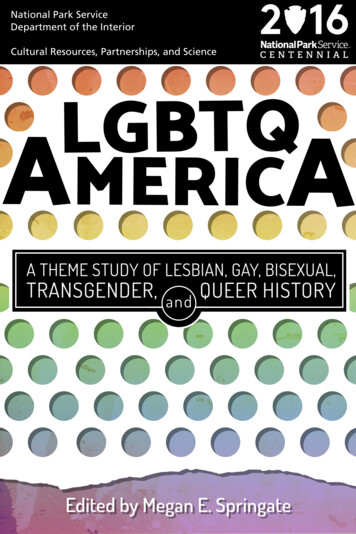
Transcription
Published online s/lgbtqthemestudy.htmLGBTQ America: A Theme Study of Lesbian, Gay, Bisexual, Transgender,and Queer History is a publication of the National Park Foundation and theNational Park Service.We are very grateful for the generous support of the Gill Foundation, whichhas made this publication possible.The views and conclusions contained in the essays are those of theauthors and should not be interpreted as representing the opinions orpolicies of the U.S. Government. Mention of trade names or commercialproducts does not constitute their endorsement by the U.S. Government. 2016 National Park FoundationWashington, DCAll rights reserved. No part of this publication may be reprinted orreproduced without permission from the publishers.Links (URLs) to websites referenced in this document were accurate at thetime of publication.
THEMESThe chapters in this section take themes as their starting points. They exploredifferent aspects of LGBTQ history and heritage, tying them to specific places acrossthe country. They include examinations of LGBTQ community, civil rights, the law,health, art and artists, commerce, the military, sports and leisure, and sex, love, andrelationships.
22LGBTQ AND HEALTHKatie BatzaIntroductionDebates over what constitutes health and sickness have shapedLGBTQ history, identities, community building, and political activism in theUnited States since at least the nineteenth century. Deployed bymainstream medicine and utilized by sexual and gender minorities,“health” has fueled, reinforced, and challenged ideals of sexuality andgender, particularly as they have intersected with perceptions of race,class, ability, morality, and citizenship. In LGBTQ history, health has alwaysmeant more than simply charting rates of various illnesses and treatments,as the concept has been so crucial in defining and redefining LGBTQpeople and communities. Consequently, a catalogue of LGBTQ healthrelated historic places extends far beyond the typical confines of healthsites so that prisons and asylums, bars and bathhouses, city streets andparks, hotels and conference centers, government buildings andcorporate headquarters prove equally important to the map of LGBTQhealth history as do clinics, hospitals, and laboratories.To provide some structure to this menagerie of sites as well as acorresponding timeline, I have devised three sections for this chapter:
Katie BatzaSites of Discrimination, Sites of Protest, and Sites of Service. Sites ofDiscrimination will examine the various ways and places in which “health,”sickness, and medicine have worked counterproductively against genderand sexual minorities to create pathologies and treatments thatlegitimized stigmatization and discrimination. Over time, members ofLGBTQ communities resisted their medical classifications and theresulting mistreatment, sites of which I will explore in the Sites of Protestsection. Sites of Service will document places where members of theLGBTQ community and allies within the medical field offered health careand services to LGBTQ individuals and where LGBTQ individuals havemade significant contributions to medicine and health. While thesecategories allow for a roughly chronological historical narrative thatshowcases the full range of possible historic sites and illustrates thecomplexity of the relationship between health and LGBTQ histories, thecategories are somewhat arbitrary and also fluid. For example, while I maylist and explore a LGBTQ clinic in the Sites of Service section, it could alsoeasily fit into the Sites of Protest section. Similarly, I list some places asSites of Discrimination even as they were clearly Sites of Service becausethey illustrate the type and degree of discrimination common for LGBTQindividuals and communities in different periods. These sections willprovide a brief historical overview of when, how, and why discrimination,protest, and service molded LGBTQ history, as well as an examination ofrelated historic sites. While far from exhaustive, this approach shouldprovide a strong orientation for future research on LGBTQ historic healthsites.In each of the following sections, as in LGBTQ history more generally,the concept of health works in two distinct, but overlapping ways: as itrelates to LGBTQ communities as a group/groups and as it relates toindividuals. From almost the first instances of medical research on sexualand gender minorities, which occurred in the late 1800s, doctors andscientists labeled them “deviant,” “pathological,” and “unnatural.” Thesemedical designations then bolstered social stigma, legal persecution, anddiscrimination against the newly defined minorities. Consequently, early22-2
LGBTQ and Healthdefinitions of normal sexual “health” excluded and ostracized gender andsexual minorities as a group/groups so much so that many avoidedpossible diagnoses of sexual or gender “deviance” for fear of theconsequences that included incarceration, job loss, and social ostracism.This group experience of “health,” or perhaps more accurately “sickness,”had serious implications for health on the individual level as well.Individuals fearful of a possible sexual or gender “deviant” diagnosisavoided doctors to such an extent that, when they finally did go to thedoctor about an unrelated health concern, gender and sexual minoritieswould often have illnesses more advanced and difficult to treat than their“normal” counterparts. This scenario continues to play out even today asmembers of the LGBTQ community still report higher mortality rates thanheterosexuals for many illnesses, including various cancers.1 Thoseindividuals already classified as sexual or gender minorities found theirpersonal experiences in doctor’s offices frustrating and counterproductiveas many doctors focused on treating their perceived deviance rather thantheir actual illnesses. Understandings and definitions of health, bothgroup and individual experiences of it, changed within and among theLGBTQ communities over time, but it has remained a consistentlyimportant factor in LGBTQ identity formation, community building, andpolitics.Sites of DiscriminationWhile legal and social discrimination certainly predated medicalresearch of gender and sexual minorities, the terminology and pathologythat resulted from the work of early sexologists, a new subfield of scientificresearch that emerged in the late 1800s to study sex and sexual practices,legitimized, perpetuated, and compounded this mistreatment. Inspired inpart by Social Darwinism, eugenics, and the new interest in taxonomies,scientists and doctors of the 1880s began to study and categorize sexualJessica P. Brown and J. Kathleen Tracy, "Lesbians and Cancer: An Overlooked Health Disparity,"Cancer Causes & Control 19, no. 10 (2008); Kenneth H. Mayer et al., "Sexual and Gender MinorityHealth: What We Know and What Needs to Be Done," American Journal of Public Health 98, no. 6(2008): 909-995.122-3
Katie Batzabehaviors and gender nonconformity. In creating new medical categoriesand identities, these scientists changed the social understanding ofhomosexuality and gender nonconformity by interpreting sex acts andgender presentations as indicative of identity. Previously, for example,homosexuality did not exist as an identity; instead, people participated inhomosexual activities and society viewed those acts, not necessarily thepeople who committed them, as perverse. With these new medicalidentities and the pathologies, diagnoses, and treatments that soonfollowed, doctors of the late 1800s and early twentieth century emergedas incredibly powerful regulators of gender and sexual expression as wellas arbiters of sickness and health.Diagnoses of “deviance,” “sexual inversion,” and “transvestism,” allcommon medical terminology by the early twentieth century, had thepotential to ruin lives, or at least drastically alter them, causing many, likeMurray Hall, to attempt living undetected.2 Born “Mary Anderson” inScotland in 1840, Hall immigrated to the United States where he beganliving as a man, married two women over the course of his life, andeventually became a well-known politician at Tammany Hall in New YorkCity. Only after his death from breast cancer in 1901 did Hall’s femalebiology become widely known, sparking a national scandal and muchintrigue.3 Though publicized as unique and shocking, Murray Hall was farfrom the first woman to assume a male identity during a time when menhad much greater privileges economically, socially, and politically. He wascertainly was not the only to die, in part, from his fear of a doctordiscovering his gender nonconformity or sexuality. Yet fear and avoidanceof medical treatment were hardly the only operative factors in this period.Medicine worked much more as a criminalizing and penalizing force formany gender and sexual minorities during the first half of the twentiethHavelock Ellis, Sexual Inversion, Studies in the Psychology of Sex (Philadelphia: F.A. Davis Co.,1901); R. von Krafft-Ebing, Psychopathia Sexualis: Mit Besonderer BerüCksichtigung Der ConträRenSexualempfindung: Eine Klinisch-Forensische Studie, 2. verm. und verb. Aufl. ed. (Stuttgart, Germany:Ferdinand Enke, 1887). The Murray Hall Residence is located in Greenwich Village, New York City,New York.3 "Amazed at Hall Revelations," Chicago Tribune, January 19, 1901.222-4
LGBTQ and Healthcentury than as a healing one.4 Doctors and sexologists’ work extendedfar beyond the hospital and doctor’s office as they became expertwitnesses, like sexologist Dr. James Kiernan in Chicago, at the criminaltrials of gender and sexual minorities, or medical examiners of immigrantsat Ellis Island where they regularly denied entry to immigrants suspectedof homosexuality, or consultants to the government, like those at theMenninger Clinic and Sanatorium in Topeka, Kansas on how to useRorschach tests to identify homosexuals in the military and in the StateDepartment during World War II.5 Those diagnosed as “deviant” faced awide array of possible responses ranging from temporary acceptance ofbehavior attributed to a short phase of sexual development to statemandated commitment to criminal insane asylums for indeterminatesentences.6 The individual’s race, class, gender, immigration status, ability,and family often, though not always, informed their experiences postdiagnosis.7Certainly gender presentation, lack of family support, and povertyshaped the life of Lucy Ann Lobdell, an unemployed widow from DelawareCounty, New York who wore men’s clothing and went by the name “Joe”for much of his adulthood. In 1876, Joe was imprisoned after his wife’suncle discovered he was a female. Reunited with his wife upon his releasemany months later, Joe became impoverished and then, at the urging ofthe almshouse keeper, committed to the Willard Asylum for the ChronicJennifer Terry, An American Obsession: Science, Medicine, and Homosexuality in Modern Society(Chicago: The University of Chicago Press, 1999).5 Alexis Coe, Alice Freda Forever: A Murder in Memphis (San Francisco: Houghton Mifflin Harcourt,2014); Margot Canaday, The Straight State: Sexuality and Citizenship in Twentieth-Century America(Princeton, NJ: Princeton University Press, 2009); Martin S. Bergmann, "Homosexuality on theRorschach Test," Bulletin of the Menninger Clinic (1945); and Ivan Crozier, "James Kiernan and theResponsible Pervert," International Journal of Law and Psychiatry 25, no. 4 (2002). The JamesKiernan residence is located in Chicago, Illinois. Ellis Island, in New York Harbor, is part of the Statueof Liberty National Monument (designated October 15, 1965). The Statue of Liberty NationalMonument is managed by the NPS, and was listed on the NRHP on October 15, 1966. The MenningerClinic and Sanatorium site operated from 1925 through 2003 at 5800 SW Sixth Street in Topeka,Kansas.6 Don Romesburg, "The Tightrope of Normalcy: Homosexuality, Developmental Citizenship, andAmerican Adolescence, 1890-1940," Journal of Historical Sociology 21, no. 4 (2008).7 Siobhan B. Somerville, Queering the Color Line : Race and the Invention of Homosexuality inAmerican Culture, Series Q (Durham, NC: Duke University Press, 2000); and Julian Carter, The Heart ofWhiteness: Normal Sexuality and Race in America, 1880-1940 (Durham, NC: Duke University Press,2007).422-5
Katie BatzaInsane (Figure 1) where he eventually died in 1890 after nearly ten yearsof “treatment.”8 The Willard Asylum, like many asylums of the latenineteenth and early twentieth century, frequently housed gender andsexual “deviants” for indeterminate sentences because medicine at thetime had determined their “deviancy” possibly contagious and a danger tosociety, a view that also fueled the sexual psychopath laws of the midtwentieth century that incarcerated thousands in prisons forindeterminate sentences.9Throughout the twentieth century, medicine—particularly the field ofpsychology—slowly evolved its understanding of sexuality and gender sothat new “treatments” began to emerge, all of which generally left patientsphysically or psychologically scarred and mistrusting of medicine.10 Evenas asylums and prisonstransitioned from placesthat quarantined thecriminal and mentally ill toplaces of potential“rehabilitation” during themiddle decades of thetwentieth century,concomitant “treatments”that included hormonalcastration, lobotomy, andFigure 1: A 1974 view of the Willard Asylum, where Ann Lubdellremained captive for nearly a decade before her death inpsychoanalysis often did1890. The Willard Asylum was one of many asylums across thecountry where gender and sexual minorities were committedmore harm than good.against their wills and for indeterminate sentences during theWith the new psychological late nineteenth century and for much of the twentieth. Photoby Richard Meams, courtesy of the National Park Service.theories of the esteemedP.M. Wise, "Case of Sexual Perversion," The Alienist and Neurologist 4, no. 1 (1883); James G.Kiernan, "Original Communications. Insanity. Lecture XXVI. - Sexual Perversion," Detroit Lancet 7, no. II(1884); and Jonathan Katz, Gay American History: Lesbians and Gay Men in the U.S.A.: ADocumentary (New York: Crowell, 1976), 601. The Willard Asylum for the Chronic Insane in Ovid, NewYork was listed on the NRHP on June 7, 1975.9 Tamara Rice Lave, "Only Yesterday: The Rise and Fall of Twentieth Century Sexual Psychopath Laws,"Louisiana Law Review 69, no. 3 (2009); and Estelle Freedman, ""Uncontrolled Desires": The Responseto the Sexual Pyschopath, 1920-1960," The Journal of American History 74, no. 1 (1987).10 Martin B. Duberman, Cures : A Gay Man's Odyssey (New York: Dutton, 1991).822-6
LGBTQ and HealthDr. Joseph Wolpe at Temple University and the nurturing of the wellregarded researchers at the Masters and Johnson Institute, the 1960switnessed the widespread adoption of aversion therapy, a new outgrowthof the flourishing field of psychology.11 Aversion therapy deliveredunpleasant physical experiences (often in the form of electric shocks) tomen and women who showed arousal at homoerotic images. The theorybehind aversion therapy hypothesized that after treatment, patients wouldassociate homosexual arousal with pain and unpleasantness, trainthemselves to shun homosexual thoughts, and thus cure themselves ofhomosexuality. While widely accepted and practiced in the 1960s, thistreatment coincided with shifting sexual norms, budding gay politicalactivism, and a growing minority of psychiatrists that questioned thevalidity of homosexuality’s classification as a mental illness. Thesechanges caused the removal of homosexuality from the AmericanPsychiatric Association’s Diagnostic and Statistical Manual of MentalDisorders (DSM) in 1973.Despite the important 1973 reclassification of homosexuality as nolonger pathological, mainstream medicine remained a source ofdiscrimination for many gender and sexual minorities for the remainder ofthe twentieth century. For one, numerous other diagnoses specific togender nonconformity and some sexual practices remained classified asmental illnesses, ensuring that stigma endured for a large number ofLGBTQ people and even making diagnoses of mental illness a prerequisiteBasil James, "Case of Homosexuality Treated by Aversion Therapy," British Medical Journal 1, no.5280 (1962): 768; M.P. Feldman and M.J. MacCulloch, "The Application of Anticipatory AvoidanceLearning to the Treatment of Homosexuality: 1. Theory, Technique and Preliminary Results," BehaviourResearch and Therapy 2, no. 2 (1964): 165-183; M.J. MacCulloch and M. P. Feldman, "AversionTherapy in Management of 43 Homosexuals," British Medical Journal 2, no. 5552 (1967): 594-597;John Bancroft, "Aversion Therapy of Homosexuality: A Pilot Study of 10 Cases," The British Journal ofPsychiatry 115, no. 529 (1969): 1417-1431; Joseph Wolpe, The Practice of Behavior Therapy, 3rd ed.,Pergamon General Psychology Series (New York: Pergamon Press, 1982); and William H. Masters andVirginia E. Johnson, Homosexuality in Perspective (Boston: Little, Brown and Company, 1979). Dr.Joseph Wolpe’s office was located on the campus of Temple University Medical School, Henry Avenue,Philadelphia, Pennsylvania. The Masters and Johnson Institute opened in 1964 as the ReproductiveBiology Research Foundation at 4910 Forest Park Boulevard, St. Louis, Missouri. In 1978, it becamethe Masters and Johnson Institute, and closed in 1994.1122-7
Katie Batzafor hormones or surgery for trans* individuals desiring those services.12Second, the removal of homosexuality from the DSM did not bring an endto treatment programs for homosexuality. Conversion therapy,encompassing a broad range of treatments including strict policing ofgender roles, guided visualization, and practices common in aversiontherapy, still remains common practice at the fringes of psychology,despite the disapproval of the American Psychological Association, theoverwhelming body of evidence proving its ineffectiveness, and bansagainst it in a growing number of states.13 Additionally, the medicaldisentangling of homosexuality from mental illness did not equate toquality medical care for LGBTQ patients. While a growing number ofdoctors no longer viewed their LGBTQ patients as innately sick, they rarelyknew how to ensure their health as few received any medical training onLGBTQ-specific health issues or treatment.14 Lastly, changing the medicalclassification did not erase the larger social stigma and discriminationagainst LGBTQ individuals that almost a century of medical researchhelped to build and support.The AIDS crisis of the 1980s showcased the full and lasting extent ofthis discrimination. First reported in June 1981, the new and fatal illnessdisproportionately affected gay men from the outset, a fact emphasized bydoctors, researchers, and the media to such an extent that doctors initiallyand informally called it Gay-related Immune Deficiency (GRID).15 Acquiredimmune deficiency syndrome (AIDS) became the formal name of thedisease in July 1982 at a Washington, DC meeting of gay communityTrans* is an inclusive umbrella term that encompasses a wide range of gender nonconformingpeople that might also identify as transgender, transsexual, transvestite, genderqueer, and/or otherterms. I use it here to be as inclusive and accurate as possible. Dean Spade, "Mutilating Gender," ineds., Susan Stryker and Stephen Whittle The Transgender Studies Reader (New York: Routledge,2006).13 Erik Eckholm, "California Is First State to Ban Gay 'Cure' for Minors," New York Times, September 30,2012; Tia Ghose, "Why Gay Conversion Therapy Is Harmful," in livescience (2015); and Angela DelliSanti, "Chris Christie Signs Ban on Gay Conversion Therapy," The Huffington Post, August 19, s-christie-gay-conversion-ban n 3779489.html.14 D. G. Ostrow and N. L. Altman, "Sexually Transmitted Diseases and Homosexuality," SexuallyTransmitted Diseases 10, no. 4 (1983); D. G. Ostrow and D. M. Shaskey, "The Experience of theHoward Brown Memorial Clinic of Chicago with Sexually Transmitted Diseases," ibid. 4, no. 2 (1977).15 "Gay Cancer Focus of Hearing," The Washington Blade, April 16, 1982; and L.K. Altman, "NewHomosexual Disorder Worries Health Officials," New York Times, May 11, 1982.1222-8
LGBTQ and Healthleaders, government, and Centers for Disease Control and Prevention(CDC) officials, where gay leaders argued against GRID’s inaccuracy andstigma, but the association remains intact today. Consequently,homosexual men as a group, whether infected or not, experiencedextreme forms of discrimination in health care, employment, and everydaylife as the public feared contracting the deadly disease that no one, at thetime, understood. For those infected, the stigma and fear surroundingAIDS translated into tragic injustices ranging from denial of hospitalservice, eviction, job loss, ejection from public spaces such as pools andschools, and even rejection from funeral homes and cemeteries.16 TheBrewer’s Hotel (Figure 2), a dilapidated hotel often a site for paid sex workabove a long-standing blue-collar gay bar in Pittsburgh, exemplifies theconsequences of this discrimination. During the AIDS crisis, the hotelbecame an informal AIDS hospice for people who had lost their homes tohousing discrimination and money to ineffective and expensive treatments,literally providing them with a place to die as volunteer nurses tended tothem.17 The Arthur J. Sullivan Funeral Home in San Francisco was one ofthe few funeral homes to accept the bodies of those who died from AIDSin the earliest months and years of the epidemic.18 This discriminationexpanded in the 1980s to also affect bisexuals and men who had sex withmen. AIDS hysteria became so fever-pitched that the federal governmentmade public health history in 1988 when it sent the informationalpamphlet “Understanding AIDS” to every household in the United States,totaling approximately 126 million copies, to raise awareness and quellfear.19 The harsh realities of the early AIDS crisis expanded the list ofhistoric sites of medically-related LGBTQ discrimination exponentially innumber and scope but also created unprecedented in-depth educationaround LGBTQ health and sex more broadly that had positivePhilip James Tiemeyer, Plane Queer: Labor, Sexuality, and AIDS in the History of Male FlightAttendants (Oakland: University of California, 2013); and Sean Strub, Body Counts: A Memoir ofPolitics, Sex, AIDS, and Survival (New York: Scribner, 2014).17 The Brewer’s Hotel is located at 3315 Liberty Avenue, Pittsburgh, Pennsylvania.18 The Arthur J. Sullivan Funeral Home is located at 2254 Market Street, San Francisco, California. In2014, a developer filed plans to demolish and redevelop the property.19 D. Davis, “’Understanding AIDS’ – The National Mailer,” Public Health Reports 106, no. 6 (1991).1622-9
Katie BatzaFigure 2: The Brewer’s Hotel above a long-standing working-class gay bar and across the street froman old brewery became an impromptu AIDS hospice during the 1980s. Volunteer nurses would gofrom room to room caring for the gay men who had lost their homes and livelihoods as a result oftheir battle with HIV/AIDS. Photograph 2015, courtesy of Joseph W. Edgar.repercussions on the health of people both in and beyond LGBTQcommunities.Sites of ProtestWhile manipulating definitions of health proved a useful tool ofdiscrimination against LGBTQ people and communities starting in the1880s, it also sparked various forms of protest. In creating sexual andgender minority identities, medicine also inadvertently helped createcommunities of people who shared those new identities, includingexperiences of fear, discrimination, and mistreatment, as well as a desirefor change. That same change had, in fact, been the intention of some ofthe earliest sexologists. Those whose work introduced “sexual inversion,”“transvestism,” and “deviance” into the scientific lexicon and legitimizedexisting social stigmas actually intended to create more understanding22-10
LGBTQ and Healthand acceptance of sexual and gender minorities.20 While doctors in theUnited States in the early twentieth century mostly embraced the morediscriminatory aspects of sexological taxonomies, some “deviants” clungto their potential use for social acceptance. In December 1924, inspiredby the work of German sexologist Magnus Hirschfeld, Bavarian immigrantHenry Gerber and African American pastor John T. Graves cofounded theoldest documented homosexual rights organization in the United States,the Chicago-based Society for Human Rights.21 Though they faced policeharassment and the organization only survived a few months, the charter“to promote and protect the interests of people who by reasons of mentaland physical abnormalities are abused and hindered in the legal pursuit ofhappiness,” makes clear the importance of medical diagnosis in theorganization’s origins.22In the mid-twentieth century, activists changed tactics, challenging themedical diagnoses themselves rather than trying to harness their potentialto create more social acceptance—as the Society for Human Rightsunsuccessfully had. The 1948 and 1953 medical research studies fromthe Kinsey Institute in Bloomington, Indiana that suggested homosexualitywas much more common than previously thought and Evelyn Hooker’s1957 findings at the University of California at Los Angeles thatquestioned the categorization of homosexuality as an illness bolstered thisperspective.23 Local chapters of the midcentury homophile organizationthe Mattachine Society approached the questions of diagnosis and illnessMagnus Hirschfeld, Die Homosexualität Des Mannes Und Des Weibes, Handbuch Der GesamtenSexualwissenschaft in Einzeldarstellungen (Berlin: L. Marcus, 1914).21 The Henry Gerber residence is located within the Old Town Triangle Historic District (listedNovember 8, 1984) in Chicago, Illinois. It was designated an NHL on June 19, 2015.22 Katz, Gay American History, 386-387.23 Institute for Sex Research and Alfred C. Kinsey, Sexual Behavior in the Human Female(Philadelphia: Saunders, 1953); Alfred C. Kinsey, Wardell Baxter Pomeroy, and Clyde E. Martin, SexualBehavior in the Human Male (Philadelphia: W. B. Saunders Co., 1948); and E. Hooker, "TheAdjustment of the Male Overt Homosexual," J Proj Tech 21, no. 1 (1957). The Kinsey Institute forResearch on Sex, Gender, and Reproduction is currently located at the University of Indiana, MorrisonHall 302, 1165 E Third Street, Bloomington, Indiana. When established in 1947, it was located inBiology Hall (now Swain Hall East); in 1950, the institute moved to Wylie Hall (on the NRHP as part ofthe Old Crescent Historic District, listed on September 8, 1980; in 1955 relocated to Jordan Hall, andin 1967 moved to its current location (The Kinsey Institute website, “Chronology of Events” html). Evelyn Hooker’s office was located in thePsychology department at the University of California, Los Angeles.2022-11
Katie Batzadifferently with Frank Kameny insisting “Gay is Good” as he led theWashington, DC chapter in its fight against the federal government’s postWorld War II policy to identify and terminate all homosexual employees.24The New York City chapter saw the questions around homosexuality andhealth produce infighting and eventual fracture of the group, with one sidewanting to accept but de-emphasize their classification as mentally ill andthe other challenging the diagnosis.25 From this perspective, medicine andhealth played a central and crucial role in kick-starting the earliest LGTBQpolitical activism and also in shaping the ways that activism evolved overtime.The flow of influence was multidirectional and LGBTQ political activismin turn, shaped medicine. Beginning in 1970, LGBTQ individuals, mostlyformer patients of psychiatrists who no longer accepted the validity ofhomosexuality as a mental illness, began protesting the AmericanPsychological Association’s (APA) annual meetings, first at the SanFrancisco Civic Auditorium in 1970 then at the Sheraton-Park Hotel inWashington DC the following year. In 1972, as the APA met in the DallasMemorial Auditorium and Convention Center, a man donning a paper sackto hide his identity and calling himself Dr. Anonymous appealed to hiscolleagues when he spoke of the challenges he faced as a psychiatristwho was also gay.26 The protests proved effective when, in 1973 at theSheraton Waikiki Hotel, members of the APA voted to removeDavid K. Johnson, The Lavender Scare: The Cold War Persecution of Gays and Lesbians in theFederal Government (Chicago: University of Chicago Press, 2004); and John D'Emilio, Sexual Politics,Sexual Communities: The Making of a Homosexual Minority in the United States, 1940-1970, 2nd ed.(Chicago: University of Chicago Press, 1998). Dr. Franklin E. Kameny’s residence in Washington, DCwas listed on the NRHP on November 2, 2011.25 D’Emilio, Sexual Politics, Sexual Communities.26 Ronald Bayer, Homosexuality and American Psychiatry: The Politics of Diagnosis (Princeton, NJ:Princeton University Press, 1987); Jack Drescher and Joseph P. Merlino, American Psychiatry andHomosexuality: An Oral History (New York: Harrington Park Press, 2007). The San Francisco CivicAuditorium, now known as the Bill Graham Civic Auditorium, is located at 99 Grove Street, SanFrancisco, California. The Sheraton-Park Hotel, now known as the Washington Marriott Wardman ParkHotel, is located at 2660 Woodley Road NW, Washington, DC; it was listed on the NRHP on January31, 1984. The Dallas Memorial Auditorium and Convention Center, now known as the Kay BaileyHutchison Convention Center, is located at Canton and Akard Streets, Dallas, Texas.2422-12
LGBTQ and Healthhomosexuality from the DSM,from which its members drewdiagnoses.27 However, the 1973vote did not mark
of Liberty National Monument (designated October 15, 1965). The Statue of Liberty National Monument is managed by the NPS, and was listed on the NRHP on October 15, 1966. The Menninger Clinic and Sanatorium site operated from 1925 through 2003 at 5800 SW Sixth Street in Topeka, Kansas.
